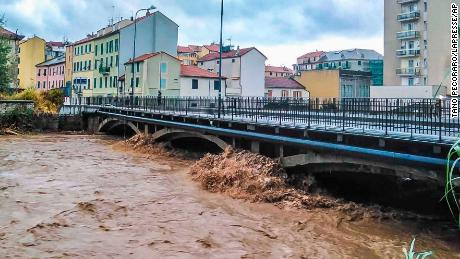Over two feet of rain fell in Italy in only half a day, something not seen in Europe before

On Monday, a series of storms put on the parking brakes over northwestern Italy, unleashing rainfall rates never before seen in all of Europe after over 29 inches (742 mm) of rain fell in just 12 hours. In Oman, a rare tropical cyclone dumped years’ worth of rainfall, bringing deadly floods to the desert landscape that rarely sees much rain in an entire year. Feet of rain in half a dayLess than 2 days earlier and a little over 3,000 miles to the southeast, Cyclone Shaheen made landfall in far northern Oman with winds just shy of a Category 1 hurricane. The storm drenched the normally parched city of Al Khaburah with over 14 inches (300 mm) of rainfall in a matter of hours, according to The Times of Oman. This is the equivalent of more than 3 years’ worth of rainfall in about 24 hours. In the nearby town of Suwaiq, more than a years’ worth of rain fell in just 6 hours. The storm produced a remarkable 4.57 inches (116 mm) of rainfall in a 6-hour span, exceeding what it typically sees in an entire year, according to Oman’s Meteorological Department.A warming globe allows room for more rainfallThe significant increase in heavy rainstorms observed around the world is becoming more evident. As the global temperatures rise, extreme precipitation events will drop more water, according to a report by the Intergovernmental Panel for Climate Change. The report highlighted that for every 1 degree Celsius (1.8°F) increase in air temperatures, the atmosphere can retain roughly 7% more water vapor.
In the US, the summer of 2021 exemplified this as tropical systems such as Ida and Henri rewrote the record books several times over in a span of weeks. In August, Tennessee shattered its previous state record after 17 inches of rain fell in the town of McEwen in just 24 hours. A little over a week later, remnants of Hurricane Ida brought torrents of rainfall across the northeastern, setting daily and all-time records from New Jersey to New England. These extreme rainfall rates are becoming more common because of human-caused global warming, scientists say. According to the UN’s report on climate change, “the frequency and intensity of heavy precipitation events have increased since the 1950s over most land area.”Deadly flash floods also made headlines around the world this summer, including deadly floods in July across Western Europe, after several months’ worth of rain fell in hours, turning city streets in Belgium and Germany into torrents of water.Heavy rainfall also caused floods in Central China in July that led to over 300 deaths. Zhengzhou, the provincial capital of 12 million people, was one of the hardest-hit areas, with entire neighborhoods submerged and passengers trapped in flooded subway cars.


